Reverse Glass Painting Exhibition at Dia.lo.gue, Observerid
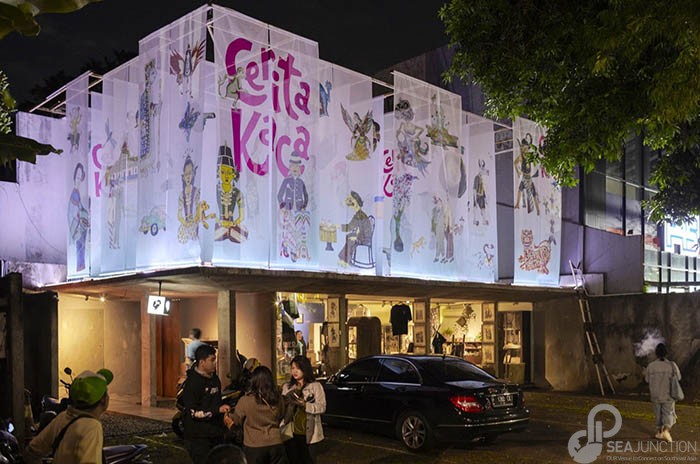
Opening at Dia.lo.gue of the Cerita Kaca reverse glass painting exhibition. Photo credit: Riop (private collection)
Jakarta, IO – Hermawan and Engel Tanzil, the owners of Dia.lo.gue gallery in Kemang, Jakarta launched a truly impressive exhibition of reverse glass paintings on the 3rd of February 2024. The exhibition will be open to the public until the 19th of April 2024 and is a visually as well as mentally appealing experience. Reverse glass paintings are a special form of folk art in Indonesia that is both vibrant and charming. The artist paints an image on glass which is later viewed from the other side of the glass. Th glass paintings are often produced by untrained or even anonymous artists and are characterized by eye-catching colours with strong forms in simple designs with one-dimensional perspectives.
The exhibition was opened by philosopher actress Dian Sastrowardoyo known for her roles in films such as Pasir Berbisik (Whispering Sands), Ada Apa dengan Cinta? (Whats Up with Love?) and Kartini. Dian remarked on how democratizing reverse glass painting was as it is not a kraton or ‘palace’ art form created by the nobility but a folk art produced by ordinary people. She herself owns twelve reverse glass paintings which she first became interested in when a few years ago she visited Pasar Triwindu in Solo. She bought several glass paintings, fascinated by how they reflect an acculturation between Indonesian Islamic culture and Indonesian local cultures.
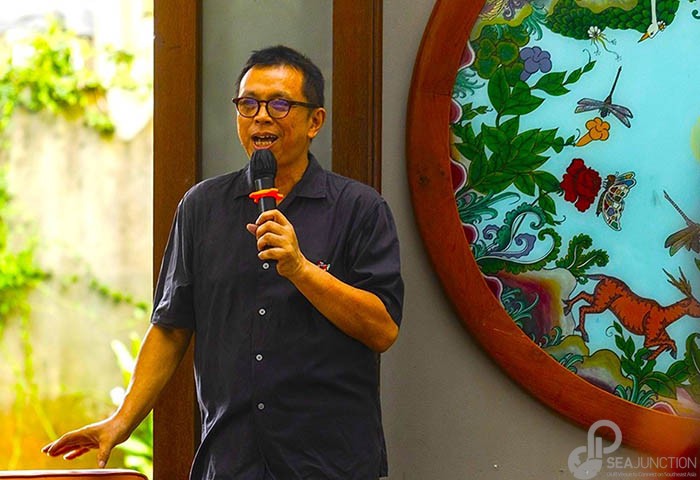
Hermawan Tanzil co-curator of Cerita Kaca exhibition and owner of Dia.lo.gue speaking at the opening. Photo credit: Riop (private collection)
Gallery owner, Hermawan Tanzil says that he was first attracted to reverse glass paintings when he saw the collection of Aji Damais, former head of the Jakarta History Museum. His interest was stimulated again while gazing at a collection of them hanging in the office of Mary Edelson, an America consultant for art and culture. It was then that he was first inspired to one day put together and hold an exhibition of reverse glass paintings. In 1990, he began collecting them himself and he now has a collection of over a hundred reverse glass paintings. He is especially fond of the folk art paintings of Madura and Java with their images of characters such as Joko Tingkir and Joko Tarung from traditional folk stories.
At the opening, Hermawan mentioned how many years later, he was again inspired to hold an exhibition of reverse glass paintings by an article in the Independent Observer about reverse glass paintings (See: https://observerid.com/through-the-looking-glass-with-lia-sciortinoindonesian-reverse-glass-paintings/ ). The article provides a short history of reverse glass painting and the different regions that produced them with particular emphasis on the collection of the Italian cultural anthropologist, Dr Rosalia Sciortino Sumarjono. He said the article rekindled his excitement for the genre.
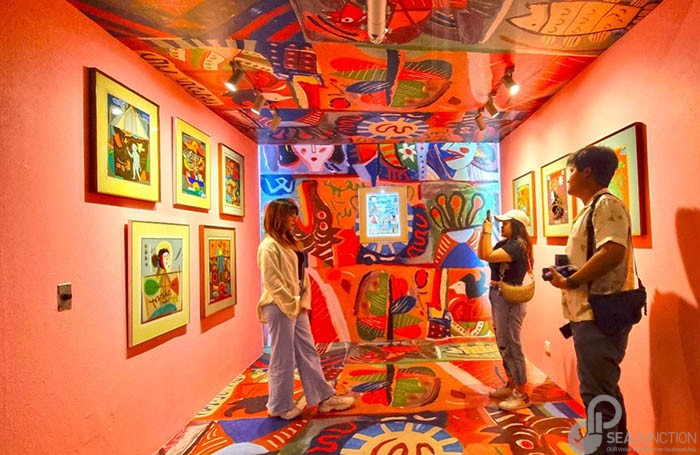
One of the inter-active installation rooms at Dia.lo.gue. (IO/Fino Simarmata)
Bandung is very much an art and culture town and Hermawan who was born there has always been interested in both. As a young man, he sang and played the gamelan. He even wrote an opera to be performed at his high school and loved visiting exhibitions. His father owned a printing house, so graphic arts were always a family interest and Hermawan later studied graphic arts first, at Fakultas Seni Rupa or the ‘Faculty of Fine Arts’ at the ITB in Bandung and later, at the California College of the Arts. He then worked for a few years abroad before returning to Indonesia in 1982 where he set up his graphic design studio, LeBoye. In 1996, he began to produce merchandize such as stationary, t-shits etc with tempo dulu Indonesian motives which he wanted to revive.
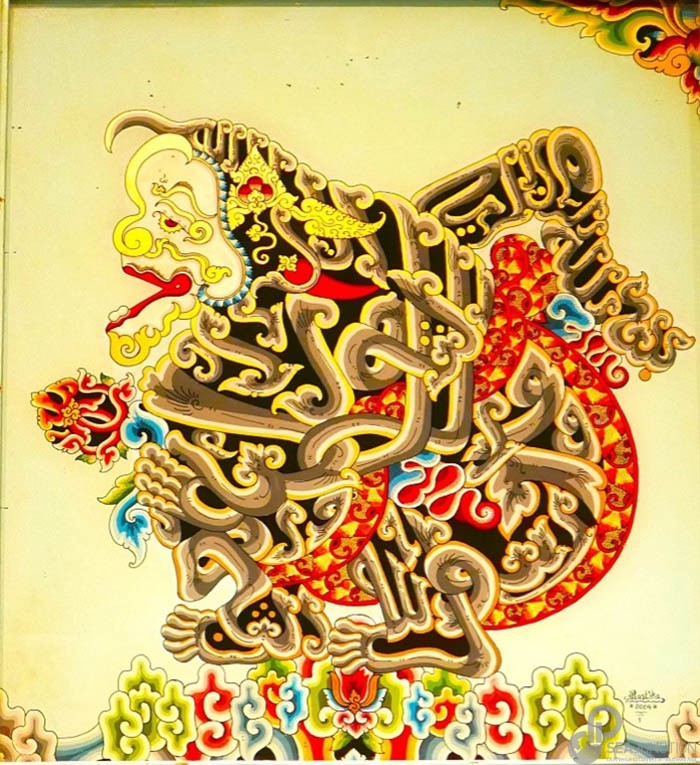
(IO/Fino Simarmata)
It was in 2010 that he first created an art space for exhibitions. For 10 years he taught at the Institut Kesenian Jakarta or ‘Jakarta Arts Institute’ where he discovered many talented young artists who were having a hard time exhibiting their work. He created Dia.lo.gue in order to give them a space to exhibit. In this it differed from other Jakarta art galleries that are generally only geared to famous artists and wealthy collectors. Besides an exhibition area, Dia.lo.gue also has an area for discussions and performances including a restaurant and merchandize shop. One of Dia.lo.gue’s best known exhibitions was an exhibition of Pramoedya Ananta Tur’s archives. At the exhibition amongst other things his books, letters from prison in Buru, photographs and typewriter were on display.
Hermawan planned Dia.lo.gue to be a place for design, art and culture and he does not want to set boundaries between art and graphic design especially now, when contemporary art is so design oriented. He says, “So much of art today requires research and a concept, storytelling, branding – which are all aspects of design thinking.”
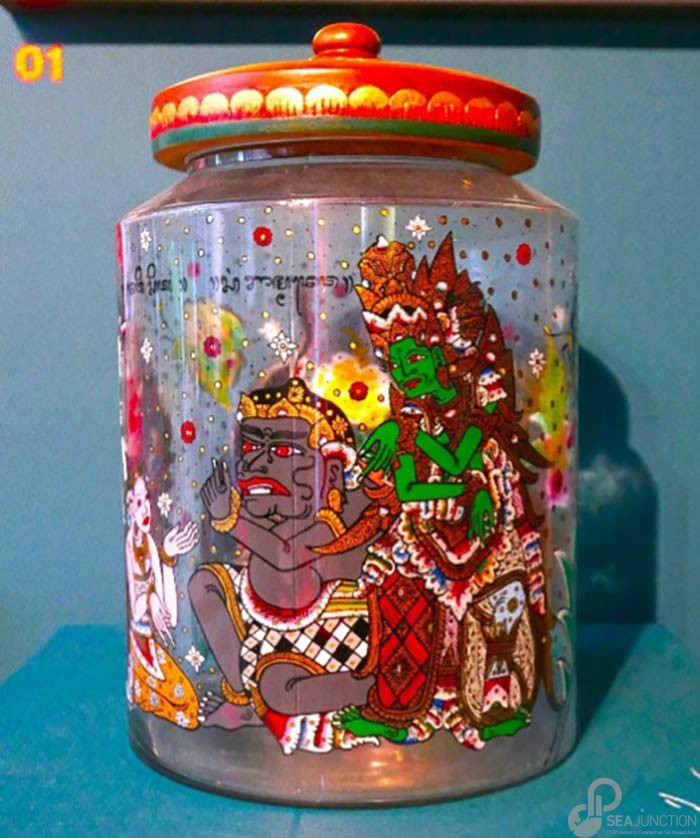
A jar with reverse glass wayang figures painted on it. (IO/Fino Simarmata)
His reserve glass exhibition also involved a lot of research, a concept and a design. It is intended to target young people so they can discover and be inspired by Indonesian art for he has found that young Indonesians hunger for art, information and history. He is saddened that so many collectors of Indonesian folk art are foreigners and hopes that with exhibitions like this one, more Indonesians will be inspired to collect Indonesian folk art.
Hermawan challenged a young graphic designer by the name of Chabib Duta Hapsoro to act as co- curator with him in creating his reserve glass painting exhibition. The exhibition consists of 238 paintings and Hermawan began by borrowing paintings from various reserve glass painting collectors. Amongst them were the Cakrabuwana Museum in Cirebon which is specifically for Cirebon art. Meanwhile, the Bentara Budaya Museum which is associated with the Kompas group, has a collection of about thousand reserve glass paintings and are the ones to have most frequently held exhibitions of reverse glass paintings. The Museum tries to help the painters by also selling their paintings. They lent Hermawan one reserve glass painting namely, the painting of a bouraq (the magical, winged horse of Islamic tradition) with the face of a wayang figure.
The Museum Lima Gunung which is owned by a cultural community in Magelang also lent him a painting. He really regrets the he was however, unable to borrow a Hendra Gunawan reserve glass painting from Museum Universitas Pelita Harapan. Few seem to be aware that the well-known artist who played a leading role in stimulating Indonesian modern art at the beginning of Indonesian independence, apparently also attempted reverse glass painting. Apart from that, twenty-five individuals and twenty-eight antique collectors lent Hermawan their paintings including six from the well-known collection of Rosalia Sciortino Sumarjono. These he hand-wrapped and personally carried from Bangkok (where Lia has her reverse glass painting collection) to Jakarta together with his loyal wife Engel. Engel Tanzil’s obsession however, is with Netherlands Indies architect, Wolf Schoemaker and his architectural creations rather than reverse glass paintings and she promises that in the future we can also expect a Wolf Schoemaker exhibition at Dia.lo.gue.
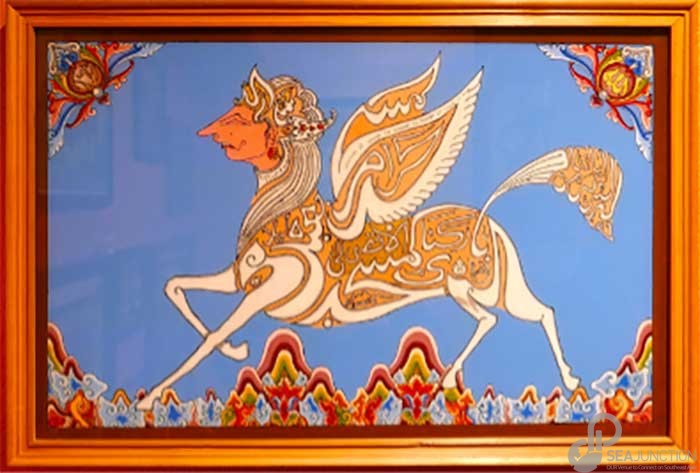
The bouraq with a wayang face lent for the exhibition by the Bentara Budaya Museum. (IO/Fino Simarmata)
Many young Indonesians attended the exhibition which also had two very colourful inter-active installation rooms that drew many to make selfies and photographs. Louis Ariffin who runs the Rumah Damais which was once the house of his uncle Aji Damais, former head of the Jakarta History Museum and son of renown archaeologist Charles Damais spoke at the opening and said, “Since little I lived in a house filled with antiques including reverse glass paintings with pictures of bouraqs and Arab calligraphy. One day, I went to Cirebon and visited Rastika, the master reverse glass painter and saw his paintings which I liked tremendously. I ordered several with wayang figures and even one with four layers of paint – and that is really, how my collection and my love of reverse glass paintings began.”
So, it was very exciting to have one of the Indonesian maestros of reverse glass painting present at the exhibition, namely Gus Dono. He is from Cirebon and it was his father, Rastika that Louis Ariffin visited. Unfortunately, Rastika who was perhaps the most famous reverse glass painter in Indonesia, passed away in 2014.
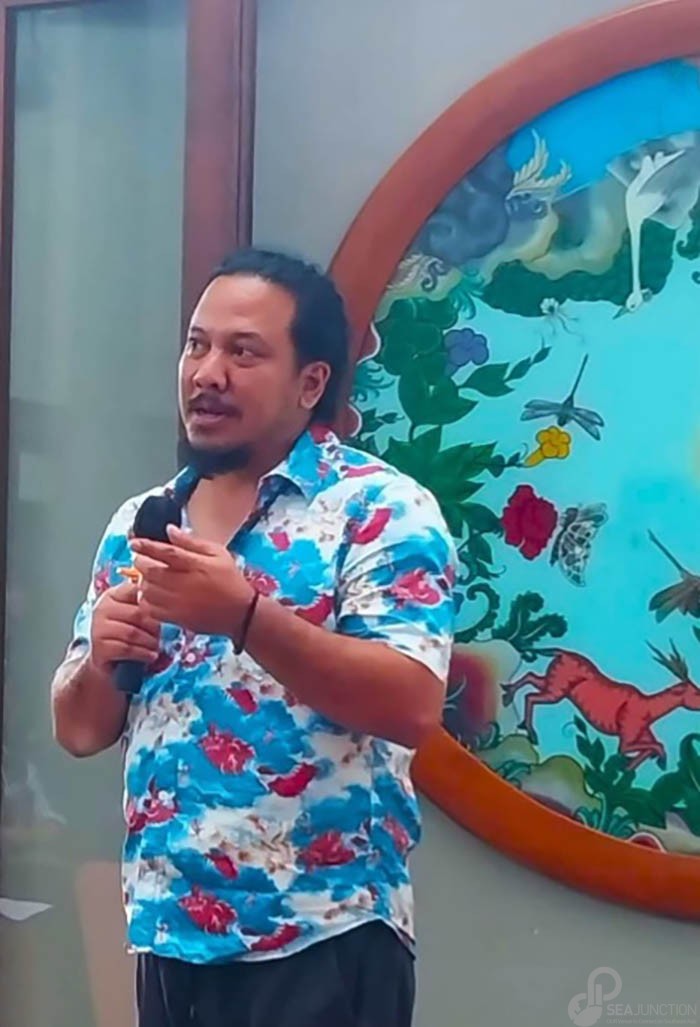
Louis Damais of Damais House spoke at the opening of Cerita Kaca. Courtesy of Louis Damais (private collection)
Rastika loved wayang performances and was a gamelan player for wayang kulit or ‘leather puppet’ performances. He was also a very creative carver who carved masks for wayang orang (classical Javanese and Balinese dance theatre in which the themes are taken from the Ramayana and the Mahabharata) dancers and the heads and shoulders of wayang golek or ‘three-dimensional wooden puppets. This multitalented man also painted the background scenes for plays and ketoprak or ‘Javanese plays using gamelan’ and traditional Javanese singing’ performances. Then one day he saw two older men who were dalangs or ‘puppeteers’, Pak Maruna and Pak Sudarga creating reverse glass paintings and soon he became engrossed in them too. Rastika’s favourite reverse glass painting themes were wayang related. Even when he painted Arabic calligraphy, it was always in the form of a wayang figure. Gus Dono remarked, “My father’s favourite wayang figure was Semar whose face may be ugly but who possesses an inner beauty and stands as an example for everyone.”
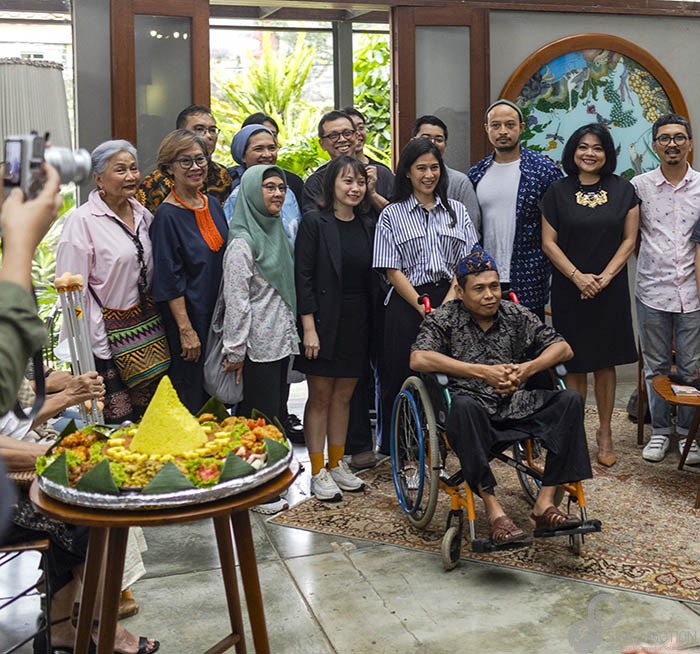
Gus Dono (centre) with Hermawan and Engel Tanzil, actress Dian Sastro, curator Chabib Duta Hapsoro and friends. Photo credit: Riop (private collection)
Gus Dono was his father’s youngest child and the only one who became a reverse glass artist. Like his father he loved wayang and painting since little. At the age of 14 he contracted polio which was hard as he was then limited to a wheelchair in his movements. His father noticed him often painting and started to guide his efforts, teaching him how to mix colours and first create sketches on the glass. Gus Dono began to help his father and a year later was allowed to create paintings on his own. People started coming to his house to look at the paintings and would buy them at the market. He currently has about thirty reverse glass paintings hanging at his house in Cirebon for sale.
At the opening of the exhibition, Gus Dono’s 13-year-old daughter, Salwa Luna Cahyu, danced the tari topeng Cirebon langgam Gegesik or the ‘Cirebon mask dance in the style of the Gegesik area’. She danced the role of Rawana, a demon and chief antagonist in the epic Ramayana with energy and verve. Gus Dono confided with a smile, “With my limited ability to move, reverse glass painting has been the greatest blessing for me as it allows me to provide for my family by doing something I love… As for my daughter she has started painting…as I once did… she may yet become a reverse glass artist – who knows!” (Tamalia Alisjahbana)
Source : https://observerid.com/reverse-glass-painting-exhibition-at-dia-lo-gue
